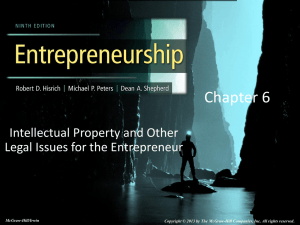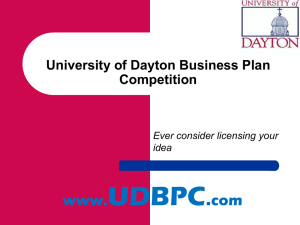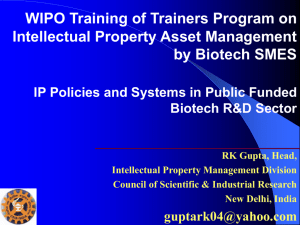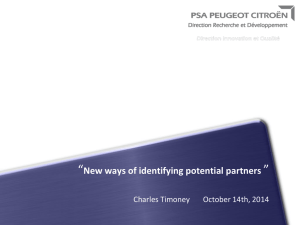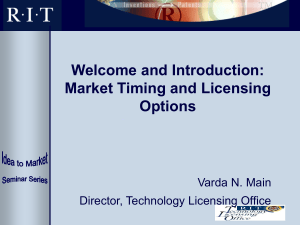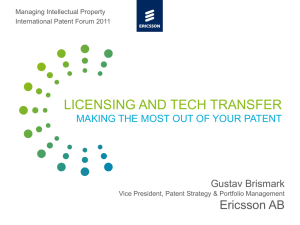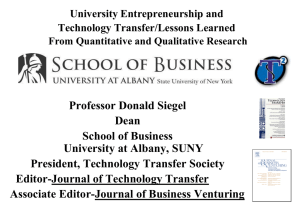Transforming Ideas into Innovations, Licensing and Ventures
advertisement
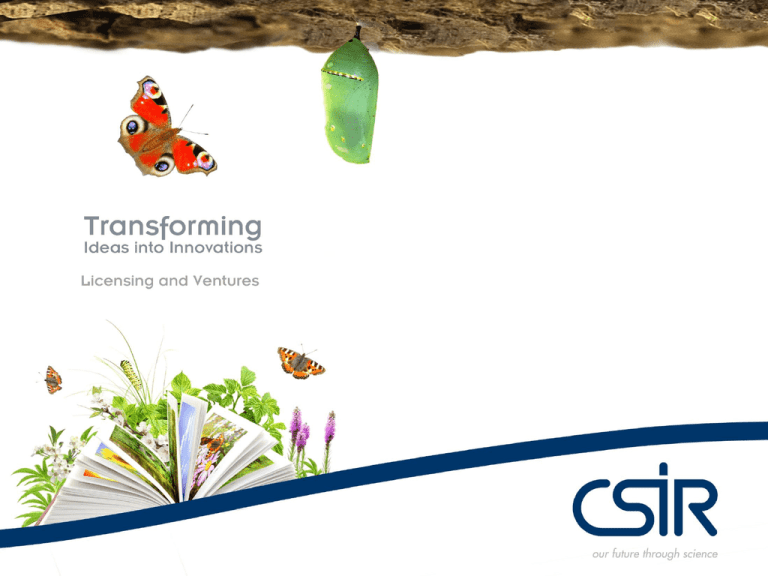
© CSIR 2012 Adoption of Socially Responsible Licensing Practices Considerations for South African Technology Transfer Offices Rosemary Wolson Senior Intellectual Property Manager CSIR Licensing & Ventures (c) CSIR 2012 2 Overview • • • • • • • • Definitions & terminology SA-specific factors Institutional culture & policies Patent filing decisions Licensing terms Supportive practices Metrics & impact Issues for further consideration Terminology • • • • • • • SRL Humanitarian use Global access Social good Social impact Public good Public interest • What is most appropriate in our context? – ‘Responsible’ to whom? – Innovation & technology for development • Is there a need to prioritise &/or reconcile? SA context • Highly regulated system – SA IPRPFRD Act • Neutral impact? – Enshrines certain preferences which promote ‘SRL’ – But takes away some discretion from organisations to set terms of collaboration & licensing – Excon Regulations • Affects assignment rather than licensing • Unintended consequences – – – – Broad-Based Black Economic Empowerment (BBBEE) Public Finance Management Act Indigenous knowledge & Bioprospecting Regulations Sub-optimal co-ordination between different departments, initiatives • Learning curve – Trying to do it as well as others • Impact (c) CSIR 2012 5 Institutional culture & policies • Organisational philosophy – CSIR Mandate: ‘To contribute to the improvement of the quality of life of the people of the Republic’ – IP&TT Strategy • Dichotomy: Commercial gain v social good • ‘Technology Transfer for social good is aimed at transferring to the society, IP and technologies that will contribute towards improving the quality of life of the people of South African (including poverty alleviation) at a macro and micro-level. The CSIR may not necessarily derive any financial returns in social good technology transfer. The key driver should be in addressing societal needs and sustainability of the solutions delivered, ownership by the communities, and use of existing and established infrastructure to deliver the solutions.’ Institutional culture & policies • Position & influence of the TTO within the organisation – Seniority of the director – Level of support from senior management – Relationship with the rest of the organisation • Perceived as enabler or watchdog? – Strategic objectives of the TTO • Pressure to be self-funding? • Activist/agent for change role? • Setting the research agenda – Prioritisation • eg Focus on local priority disease areas or all? – R&D investment decisions • Role of TTO in relevant funding allocation panels • CSIR Growth and Development Strategy, Research Impact Areas, Flagships • Strategic partnerships • Impact assessment, monitoring & evaluation – KRAs & KPIs Patent filing decisions • Reduce IP barriers • Selective patent filing – Choosing not to file in (certain) developing countries – Developing country companies can then – in theory - produce the invention without a license – Must be sure that this will in fact achieve one’s objectives • Could prevent companies in developed countries from taking up the technology all together • Could reduce interest from developing country licensees who want patent protection (where there is innovative capacity) • Access to other technology might be required to practise the invention • Access to know-how might be required • Petty patents/utility patents Reasons not to patent • • • • Least developed countries Defensive publication as an alternative Contributing to ‘patent thickets’ ‘Enablers’ – Tools & reagents Reasons to patent • Existing innovative capacity • Existing domestic industry – particularly one which exports in addition to serving local markets • Application in both developed & developing markets • Necessary to induce investment (time to development) – Private or public sector eg TIA • Obtain leverage to access other technology or know-how – Patents as ‘bargaining chips’ – Open up cross-licensing opportunities • To enable & ‘enforce’ SRL – Patents as a tool to assist in justifying tiered pricing • Developed/developing • Public/private • Open & proprietary mechanisms can and do co-exist • Freedom-to-operate considerations Licensing objectives • Availability in developing countries • Affordability in developing countries • Measures to ensure availability/affordability if licensee does not achieve necessary outcomes • Promoting competition – Balancing access & incentives • Building in some flexibility to allow for unforeseen and/or changed circumstances • Support for innovation & industry in developing countries? – – – – – R&D support & collaboration Human capital development eg exchange programmes, scholarships Knowledge & technology transfer – know-how Development of local industry/local manufacture Benefit-sharing with communities (IKS & PGR) Licensing options • Specify minimum sales volumes in developing countries – Other milestones • Humanitarian use – Reservation of rights for defined purposes &/or markets – Importance of definitions eg ‘charitable objectives’ • Market segmentation – different terms to apply: – Developed v developing countries; public v private sector – Exclusive v non-exclusive/non-assert – Exclusive (in profitable markets) with guarantees (for underserved markets) – Pricing Licensing options • Price control in developing countries – Differential/tiered pricing eg public/private – Set limits on mark-up – ‘cost+’ – Royalty sacrifice – in full or in part • Non-exclusive licensing – Open source, protected commons • Non-assert clauses/waivers – Liability to IP holders reduced • • • • Diligence/performance clauses Mandatory sub-licensing Reversion or conversion of licensed rights Walk-in rights Licensing options • Benefit-sharing with communities & providers of plant genetic resources – Monetary & non-monetary • Change of circumstances – need for flexibility – – – – New uses for unmet needs Licensee to develop or grant sublicense Licensee to consult licensor to renegotiate – agreement to agree? Benefit-sharing provisions to be crafted sufficiently broadly to cover all developments enabled by the license • Freedom-to-operate retained by licensor – For not-for-profit research use • Licensor • Others? – Diagnostic use exemptions/non-asserts Supportive practices • Selecting licensees – Local v international – Large v SMEs • Start-ups – BBBEE – Preferences in IPRPFRD Act • Do/should licenses which observe the preferences qualify as ‘SRL’? • What is a PRO’s role in implementation? – And what is a TTO’s role in implementation? – Awareness & education • Monitoring compliance & enforcing performance-related terms – To the extent feasible • Encouraging open access publishing • Creative Commons licensing of content TTO metrics • Traditional – Invention disclosures, patent applications, issued patents, license/options signed, license income, equity, start-ups formed • Social impact – – – – – Anecdotes/vignettes Open source licenses Research tools shared Benefit-sharing agreements/benefits shared with IK holders Economic modelling - put a value on social impact achieved • Estimate the savings generated from implementing a policy recommendation eg reduced health burden on state due to clean water policy; increased productivity due to a healthier population • Demonstrating & communicating impact – Case studies, success stories Concerns • Quality & liability – Risks especially high in healthcare arena • Product diversion – ‘Leakage’ – Illegal exports into countries where the exported technology will compete unfairly with licensee’s legitimate rights • Lack of capacity to exploit the technology – Need for know-how, capital investment in infrastructure • Competition/anti-trust Contextualising SRL practices • Apply to all technologies or only some? – Medical/food security/clean energy/environment? • Terms must be appropriate to the technology and take into account its value to the licensee, as well as to developing country markets – Not ‘one size fits all’ • Need to educate licensees – might require ongoing discussions • Need to grow awareness and get buy-in from other stakeholders • We’re licensing at early stage – how to influence development of the technology down the value chain? – Can we build in license terms to deal with this? • In a country like SA there are gaps in the value chain – need to identify these and fill them to ensure a holistic approach • Need to strike the right balance between social objectives & incentives What can we do as (South African) PROs? • This is not a settled field where practices are set in stone – Best practices evolving – Seek & design new solutions – Share experiences – what works & what doesn’t • • • • • Educate & create awareness If you don’t ask, you don’t get… Patent pools, clearing houses, aggregating/bundling Open innovation A need for a South African statement of guiding principles? – Most of the case studies & examples have been driven by developed country institutions & organisations – Reconcile potentially competing objectives Thank you! Rosemary Wolson rwolson@csir.co.za +27-12-841-4301 +27-83-784-3648

